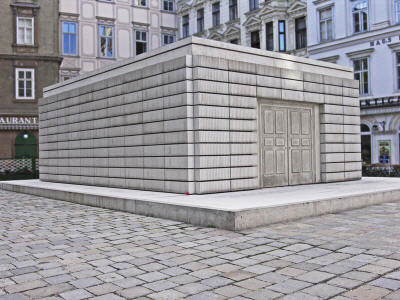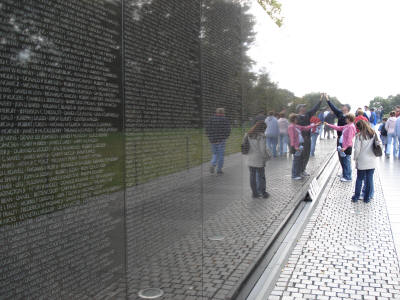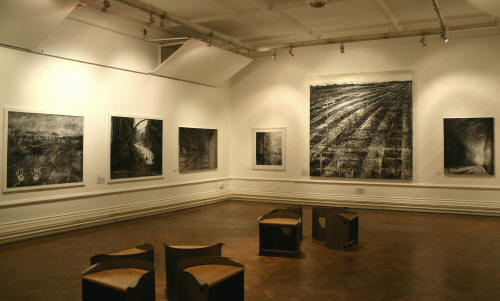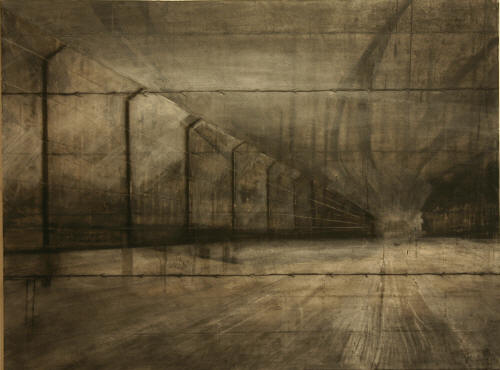|
|
| home | features | exhibitions | interviews | profiles | webprojects | gazetteer | links | archive | forum |
|
Phil Whiting Srebenica Royal Cornwall Museum, Truro
There are some who believe that the war-time atrocities that have been such a tragic feature of modern history cannot be spoken of or depicted in art. Adorno, for example, famously said that 'to write poetry after Auschwitz is barbaric'. Others believe that it is important to try to find ways to remember and honour the dead through art and writing, and celebrated contemporary monuments in Washington (below) and Vienna (above) have been large in scale but understated in emotional tone. Importantly, they were also commissioned by the communities that were affected by the tragedies. Set against these comparators, Whiting's paintings represent an ambitious and even grandiose project. How can any artist do justice to such events, especially when they had no direct involvement in the conflict? In depicting the war who does Whiting claim to speak for? The Bosnian people or all humanity? Either way he seemed to be setting himself an impossibly ambitious task.
This was a startling and daring translocation that was plausible and thought provoking at an intellectual level. Unfortunately there was also something phoney about it. Although the emotions stirred up by the brooding colours and dramatic skies were powerful and strong, the style was one borrowed wholesale by Whiting from the German painter Anselm Keifer. Rather than being a completely authentic and genuine personal expression, as was intended, the work was therefore tainted by pastiche. Ordinarily this would not be a problem, as all artists take influences from one another, but the success of these particular works seems to depend on their having complete legitimacy and integrity.
Keifer himself exploited the link between expressionism, German Romanticism and Fascism: but these are powerful themes that need to be handled with extreme care. Clearly Whiting has been moved and angered by the injustice of war, and was keen to share his outrage with others, but is this highly personal and expressionistic outpouring of emotion the most effective way to communicate the complex nature of such political and historical realities? The danger is that the immensity of the tragedy that is depicted becomes a vehicle for the artists own self-aggrandisement or self-promotion, so that in looking at the work one thinks primarily about the artist's vision and his painterly technique. In other words one thinks about the artist, rather than considering the Bosnian people themselves. This was also reflected in the choice of subject matter. Like Kiefer's landscapes, most of the images were of generic views of fields, and high fences that may or may not have been Bosnia. Whilst this had the effect of generalising the symbolism, and potentially widening its relevance to suppressed human communities all over the world, again it represented an alarming erasure of detail at the level of the individual. This could even be viewed as a silencing of the voices of the people of Bosnia, and therefore a form of violence in itself.
In fact the best works were probably those in which the expressionist elements and Kieferesque motifs were kept to a minimum, such that the image was more emotionally neutral, the artist was less present, and the viewer was freer to interpret it in whichever way they chose. For example the haunting stillness and empty geometries of the images of the fences were particularly poignant (eg 'The Safe Haven' (above)). It would be unusual, and possibly inappropriate, for visitors to come away from this exhibition saying they enjoyed it. Most will have left feeling anxious and troubled, as I did. In this sense the work cannot be judged by the usual criteria. Perhaps it is not surprising that there are not more artists who take war as their subject, because dealing with this, the hugest and most difficult subject for art - a subject that takes in history, nation states and the deaths of thousands of people - the stakes could not be higher, and the standards by the which the work is judged should be likewise. It takes courage and a huge self-belief to do so, but in speaking for whole nations regarding highly emotive subjects such as war, which as voters we are all implicated in, Whiting will probably recognise that our responses to his work are likely to be unconsciously or consciously shaped by strong emotions of guilt, anger and fear. In the final analysis, he is to be applauded for his bravery in taking on such a difficult and serious subject, and the museum staff for putting the show on. He has shown a willingness to address important issues that many artists would not even attempt.
RW 30/1/08 |
|
|




 In
fairness to Whiting, these issues apply to nearly all painting:
Keifer, Bomberg and Nash included. Though Whiting is playing to painting's strengths,
art cannot be and do everything. Painting, of all the media, will always tend to aestheticise
suffering so that sensual pleasure becomes connected to tragedy in a way
that can feel uncomfortable. Arguably expressionistic painting is best used in
the way that Whiting does: to create iconic or summary representations of suffering.
Yet I would argue such generalities come at a price.
In
fairness to Whiting, these issues apply to nearly all painting:
Keifer, Bomberg and Nash included. Though Whiting is playing to painting's strengths,
art cannot be and do everything. Painting, of all the media, will always tend to aestheticise
suffering so that sensual pleasure becomes connected to tragedy in a way
that can feel uncomfortable. Arguably expressionistic painting is best used in
the way that Whiting does: to create iconic or summary representations of suffering.
Yet I would argue such generalities come at a price.